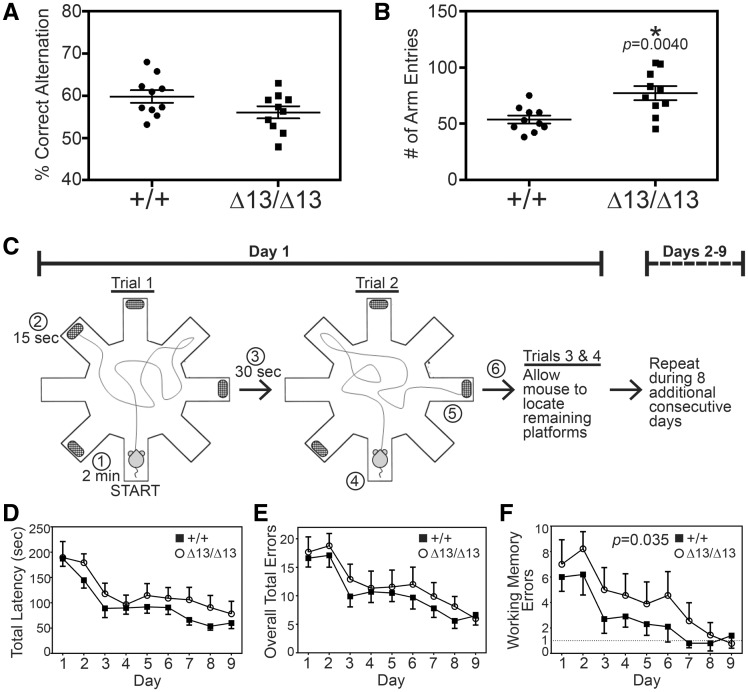Figure 4.
Zc3h14Δex13/Δex13 mice have impaired working memory but intact learning. Mice were first tested in a Y-maze paradigm to analyse (A) % Correct Alternation between arms and (B) number of Arm Entries. We compared Zc3h14+/+ (+/+) and Zc3h14Δex13/Δex13 (Δ13/Δ13) adult mice in 20 independent trials as described in Materials and Methods. (A) There was no statistically significant difference detected in the % Correct Alternation between arms of the maze. (B) There was a statistically significant increase (P = 0.004) in the number of arm entries (∼40% increase) for Zc3h14Δex13/Δex13 (Δ13/Δ13) compared to Zc3h14+/+ (+/+) mice. (C) Schematic of the WRAM apparatus and 9-day testing procedure (41). Mice are given 2 min to locate a hidden platform positioned at the far ends of four of eight arms. If a mouse is unable to locate a platform within 2 min of beginning the trial, it is gently guided to the nearest platform. Upon successful escape from water onto platform, mice are rewarded with 15 s of rest on platform, followed by 30 s of rest in a heated, dry cage. At the start of trial 2, the previously located platform is taken away and mice proceed to find one of the remaining hidden platforms. This process is repeated until all platforms are found, one in each trial. These four trials are repeated daily for a total of 9 consecutive days. Circled numbers indicate sequence of events in trials. The experiment compares Zc3h14+/+ (+/+, closed squares) to Zc3h14Δex13/Δex13 ((Δ13/Δ13, open circles) mice. (D) Total latency is the average time (seconds) required per subject to complete all four trials for a specified day of testing. Comparing by test day, P < 0.0001; comparing by genotype, P = 0.11, indicating no difference. (E) Overall total errors is the average number of errors made per subject for all four trials for a specified day. Comparing by test day, P < 0.0001; comparing by genotype, P = 0.20, indicating no difference. (F) The average number of working memory errors, represented by reentry into any maze arm during a given trial, per subject for a specified day, is shown. Dashed line at 1 working memory error represents sufficient performance on WRAM. Comparing by test day, P < 0.0001; comparing by genotype, P = 0.035, revealing a statistically significant difference. Open circles indicate Zc3h14Δ/Δ. Closed squares indicate Zc3h14+/+. Behavioral tests were performed on independent cohorts of 3-4-month-old mice. All tested mice were male. Zc3h14+/+, n = 10; Zc3h14Δex13/Δex13, n = 9. Error bars indicate SEM for (B), (C), (D).

